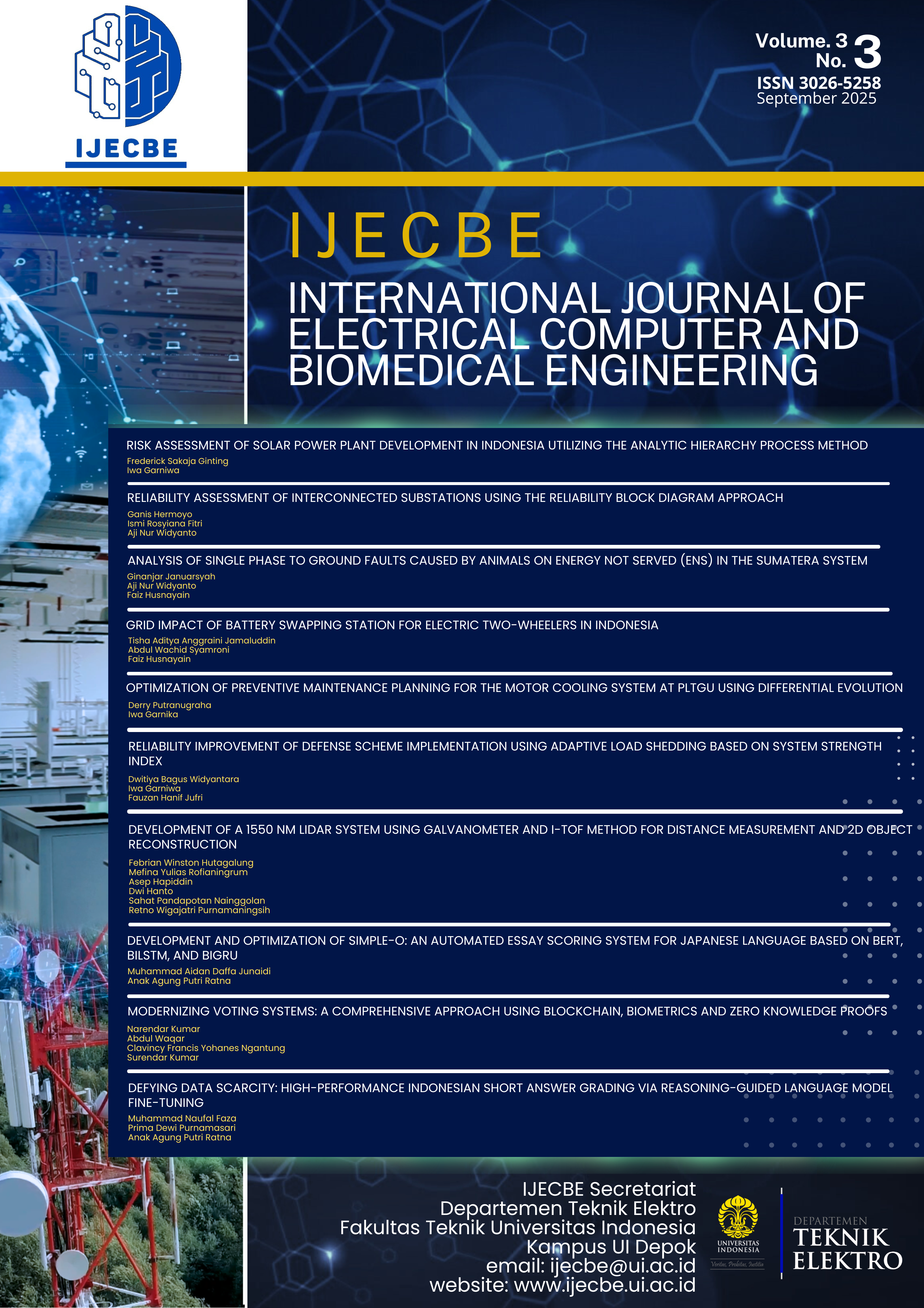Development of a 1550 nm LiDAR System Using Galvanometer and i-ToF Method for Distance Measurement and 2D Object Reconstruction
DOI:
https://doi.org/10.62146/ijecbe.v3i3.129Keywords:
LiDAR, Object Identification, i-ToF, Galvanometer, Laser 1150 nmAbstract
LiDAR (Light Detection and Ranging) is a high-precision distance measurement technology based on laser light reflection. This study develops a galvanometer-based LiDAR system utilizing the indirect Time of Flight (i-ToF) method with 100 MHz sinusoidal modulation and a 1550 nm eye-safe laser diode. The system is designed to measure distance and identify the shape of 2D objects. The system was tested through phase difference measurements, galvanometer response, and flat-surface mapping at distances of 25 cm and 35 cm. The measurement results demonstrate high linearity and stability up to a maximum range of 1.5 meters, in accordance with the 360° phase difference (∆φ) limitation. The measurements of object dimensions in the form of an aluminum foil-covered plate at distances of 25 cm (1.76 cm × 2.63 cm) and 35 cm (2.45 cm × 3.66 cm) indicate that increasing the distance between the object and the system results in a wider coverage area but with reduced spatial resolution. At a distance of 25 cm, the light beam shifts by 0.436 cm/1°∆φ, whereas at 35 cm it shifts by 0.611 cm/1°∆φ. Furthermore, the limited active area of the photodetector was identified as the main factor restricting the detection coverage. This research opens opportunities for further development, particularly in optimizing galvanometer angle adjustments and enhancing the photodetector’s active area to expand coverage and improve measurement accuracy under various operating conditions.
References
R. Roriz, J. Cabral, and T. Gomes, “Automotive LiDAR technology: A survey,” IEEE Trans. Intell. Transp. Syst., vol. 23, no. 7, pp. 6282–6297, Jul. 2022.
T.-H. Kim and T.-H. Park, “Placement optimization of multiple LiDAR sensors for autonomous vehicles,” IEEE Trans. Intell. Transp. Syst., vol. 21, no. 5, pp. 2139–2145, May 2020.
S. Royo and M. Ballesta-Garcia, “An overview of LiDAR imaging systems for autonomous vehicles,” Appl. Sci., vol. 9, no. 19, p. 4093, Sep. 2019.
P. Seoane, E. Aldao, F. Veiga-López, and H. González-Jorge, “Assessment of LiDAR-based sensing technologies in bird–drone collision scenarios,” Drones, vol. 9, p. 13, 2025.
Z. Miao, C. Gamos, Y. Shinohara, and N. Hotta, “Drone LiDAR occlusion analysis and simulation...,” Drones, vol. 9, no. 2, p. 135, 2025.
G. Mandlburger and B. Jutzi, “On the feasibility of water surface mapping with single photon LiDAR,” ISPRS Int. J. Geo-Inf., vol. 8, no. 4, p. 188, Apr. 2019.
J. H. Churnside and J. A. Shaw, “LiDAR remote sensing of the aquatic environment,” Appl. Opt., vol. 59, no. 10, p. C92, Apr. 2020.
F. Wang et al., “Design and implementation of the galvanometer scanning system...,” Chin. Opt. Lett., vol. 18, no. 12, p. 121703, 2020.
Y. Xin et al., “A low-power i-ToF LiDAR with nonlinearity self-calibration technique,” IEEE Trans. Instrum. Meas., vol. 72, 2023.
T. Raj et al., “A survey on LiDAR scanning mechanisms,” Electronics, vol. 9, no. 5, p. 741, 2020.
T. Staffas et al., “FMCW and ToF LiDAR with single photons: A comparison,” Opt. Express, vol. 32, no. 5, pp. 7332–7341, Feb. 2024.
J. Lambert et al., “Performance analysis of 3D LiDARs for automated driving,” IEEE Access, vol. 8, pp. 131699–131722, 2020.
C. Rablau, “LiDAR: A new self-driving vehicle for introducing optics to broader engineering and non-engineering audiences,” Proc. 15th Conf. Educ. Training Opt. Photon. (ETOP), vol. 11143, 2022.
J. Wojtanowski et al., “Comparison of 905 nm and 1550 nm semiconductor laser rangefinders...,” Opto-Electron. Rev., vol. 22, no. 3, pp. 183–190, 2014.
D. Hanto et al., “ToF LiDAR with dual-modulation frequency switching...,” IEEE Trans. Instrum. Meas., vol. 72, 2023.
G. Choi et al., “A method for reducing scanning error rate of LiDAR using a galvanometer,” Proc. SPIE, vol. 11155, 2019.
Q. Yuan et al., “Alignment analyses of a galvanometer-based scanner...,” Appl. Opt., vol. 54, no. 32, pp. 9554–9562, 2015.
J. Lambert et al., “Performance analysis of 3D LiDARs for automated driving,” IEEE Access, vol. 8, pp. 131699–131722, Jul. 2020.
S.-W. Lee et al., “LIDAR system using i-ToF method and MEMS scanner...,” Proc. Int. Conf. Optical MEMS and Nanophotonics (OMN), 2016.
A. Nikmah et al., “Improved i-ToF measurements for LiDAR with and without APD gain,” Instrum. Sci. Technol., vol. 52, no. 4, pp. 1–10, Jul. 2024.
Thorlabs, Inc., GVS002 Galvo Scanner System – User Guide, ver. 26, Aug. 2024
Downloads
Published
How to Cite
Issue
Section
License
Copyright (c) 2025 International Journal of Electrical, Computer, and Biomedical Engineering

This work is licensed under a Creative Commons Attribution 4.0 International License.





